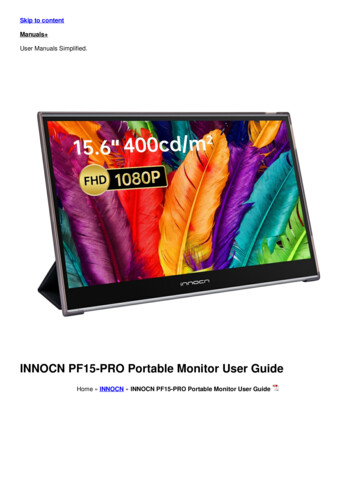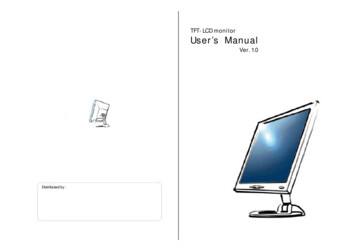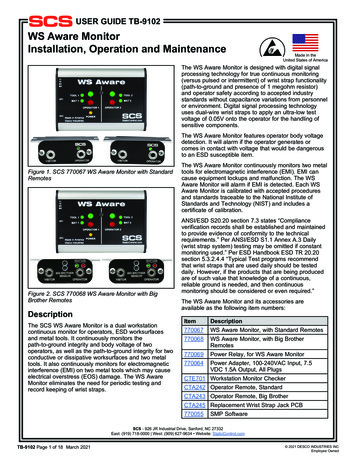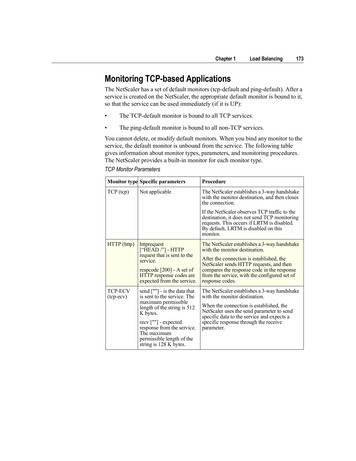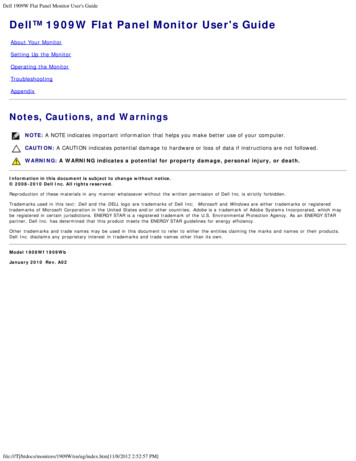
Transcription
MONITOR/DEFIBRILLATOROperating Instructions
MONITOR/DEFIBRILLATOROperating Instructions
Important InformationDevice TrackingThe U.S. Food and Drug Administration requires defibrillator manufacturers and distributors totrack the location of their defibrillators. If the device is located somewhere other than theshipping address or the device has been sold, donated, lost, stolen, exported, destroyed,permanently retired from use, or if the device was not obtained directly from Physio-Control,please do one of the following: register the device at http://www.physio-control.com, call thedevice registration phone line at 1.800.426.4448, or use one of the postage-paid addresschange cards located in the back of this manual to update this vital tracking information.Text ConventionsThroughout these operating instructions, special text characters (for example, CAPITAL LETTERSsuch as CHECK PATIENT and SPEED DIAL) are used to indicate labels, screen messages, andvoice prompts.Applicable ProductsThese operating instructions are for use with the following product catalog numbers.99577-001368, 99577-001372, 99577-001373, 99577-001588, 99577-001930, 99577-001931,99577-001932, 99577-001933, 99577-001934, 99577-001935, 99577-001936, 99577-001937,99577-001938, 99577-001939, 99577-001940, 99577-001941, 99577-001942, 99577-001943,99577-001944, 99577-001945, 99577-001946, 99577-001947, 99577-001948, 99577-001949,99577-001950, 99577-001951, 99577-001952, 99577-001953, 99577-001954, 99577-001955,99577-001956, 99577-001957, 99577-001958, 99577-001959, 99577-001960, 99577-001961,99577-001962, 99577-001963, 99577-001964, 99577-001965, 99577-001966
Physio-Control or its affiliates own, use, or have applied for the following trademarks or service marks:LIFEPAK, LIFEPAK CR, LIFEPAK EXPRESS, REDI-PAK, LIFENET, QUIK-LOOK, QUIK-COMBO, CODESUMMARY, Shock Advisory System, CODE-STAT, DT EXPRESS, SunVue, and cprMAX. All othertrademarks are trademarks of their respective owners or holders. The Oridion medical capnography inthis product is covered by one or more of the following US patents: 6,428,483; 6,997,880; 5,300,859;6,437,316 and their foreign equivalents. Additional patent applications pending. Specifications aresubject to change without notice. 2019 Physio-Control, Inc.Publication Date: 01/20193314911-011
ContentsChapter 1 Preface11Introduction . 13Intended Use. 13Modes of Operation . 14Chapter 2 Safety Information15Terms . 17General Dangers and Warnings . 17Chapter 3 Basic Orientation21Front View . 23Back View . 33Batteries . 35Home Screen . 37Alarms . 41Options . 43Events . 45Chapter 4 Monitoring47Monitoring the ECG . 49Acquiring a 12-Lead ECG . 61Monitoring SpO2, SpCO, and SpMet . 71Monitoring Noninvasive Blood Pressure . 83Monitoring ETCO2 . 91Monitoring Invasive Pressure . 99Monitoring Continuous Temperature. 107Vital Sign and ST Segment Trends . 111Chapter 5 Therapy117General Therapy Warnings and Cautions . 119Therapy Electrode and Standard Paddle Placement . 121Automated External Defibrillation (AED) . 123Manual Defibrillation . 137Synchronized Cardioversion Procedure . 143Noninvasive Pacing . 148Pediatric ECG Monitoring and Manual Mode Therapy Procedures . 154 2019 Physio-Control, Inc.LIFEPAK 15 Monitor/Defibrillator Operating Instructionsvii
Chapter 6 Paddle Accessory Options155QUIK-COMBO Therapy Electrodes . 157Standard Paddles . 160Sterilizable Internal Defibrillation Paddles . 164Chapter 7 Data Management165Patient Records and Reports . 167Memory Capacity. 173Managing Current Patient Records . 173Managing Archived Patient Records . 175Chapter 8 Data Transmission179About Transmitting Patient Records and Reports . 181Preparing the Monitor for Transmission . 182Using Bluetooth Wireless Communication . 182Using a Direct Connection . 187Transmitting Reports . 189Considerations When Transmitting Data . 191Troubleshooting Tips . 192Chapter 9 Power Adapter195Basic Orientation . 197Using the Power Adapter. 199General Maintenance . 202Warranty. 203Chapter 10 Maintaining the Equipment205General Maintenance and Testing . 207Battery Maintenance . 215Cleaning the Device . 218Storing the Device . 218Loading Paper. 219General Troubleshooting Tips . 220Service and Repair. 224Service Life . 224Product Recycling Information . 225viiiLIFEPAK 15 Monitor/Defibrillator Operating Instructions
Warranty. 225Accessories. 226Appendix A Specifications and Performance Characteristics229Specifications and Performance Characteristics . 231Appendix B Screen Messages253Summary of Screen Messages . 255Appendix C Defibrillation Clinical Summaries261Defibrillation of Ventricular Fibrillation and Ventricular Tachycardia . 263External Cardioversion of Atrial Fibrillation. 265Intra-Operative Ventricular Defibrillation. 269Clinical Summary: Monophasic vs. Biphasic Waveforms: Out-of-Hospital Trial .272Appendix D Shock Advisory System275Overview . 277Performance Verification . 278Appendix E SpO2 Specifications and Validation283SpO2 Specifications and Validation . 285Masimo Clinical Validation Data . 293Nellcor Clinical Validation Data. 294Appendix F Electromagnetic Compatibility Guidance295Electromagnetic Compatibility Guidance . 297Appendix G Symbols303Symbols . 305Index 2019 Physio-Control, Inc.311LIFEPAK 15 Monitor/Defibrillator Operating Instructionsix
Chapter 1PrefaceThis chapter provides a brief introduction to the LIFEPAK 15 monitor/defibrillator and describesthe product’s intended use.Introduction . 13Intended Use . 13Modes of Operation. 14 2019 Physio-Control, Inc.LIFEPAK 15 Monitor/Defibrillator Operating Instructions11
Chapter 1 PrefaceIntroductionThe LIFEPAK 15 monitor/defibrillator is a complete acute cardiac care response systemdesigned for basic life support (BLS) and advanced life support (ALS) patient managementprotocols.These operating instructions include information and procedures related to all features of theLIFEPAK 15 monitor/defibrillator. Your LIFEPAK 15 monitor/defibrillator may not have all of thesefeatures.These operating instructions describe the operation of the LIFEPAK 15 monitor/defibrillatorwhen the factory default settings are used. The factory default settings for all setup options areidentified in table, Setup Options Factory Default Settings (on page 250). Your device may be setup with different default settings, based on your protocols. For information about changingdefault settings, see the LIFEPAK 15 Monitor/Defibrillator Setup Options provided with yourdevice.IMPORTANT! Some LIFEPAK 15 monitor/defibrillator accessories are not interchangeable withaccessories that are used with other LIFEPAK monitor/defibrillators. Specific accessoryincompatibilities are noted in the related sections.Intended UseThe LIFEPAK 15 monitor/defibrillator is intended for use by trained medical personnel. Forinformation about training options, contact your local Physio-Control representative.The LIFEPAK 15 monitor/defibrillator can be used in out-of-doors and indoor emergency caresettings within the environmental conditions specified in Appendix A. The monitor/defibrillator isdesigned to be used during ground transportation.Monitoring and therapy functions may only be used on one patient at a time. Manual modemonitoring and therapy functions are intended for use on adult and pediatric patients.Automated external defibrillation mode is intended for use on patients eight years of age andolder.For additional intended use information, and information about the indications andcontraindications of the monitoring and therapy functions, see the individual sections identifiedbelow. ECG MonitoringSee Monitoring the ECG (on page 49)Standard feature 12-Lead ElectrocardiographySee Acquiring a 12-Lead ECG (on page 61)Optional SpO2, SpCO, and SpMetMonitoringSee Monitoring SpO2, SpCO, and SpMet(on page 71)Optional Noninvasive Blood PressureMonitoringSee Monitoring Noninvasive Blood Pressure Optional(on page 83) End-Tidal CO2 MonitoringSee Monitoring ETCO2 (on page 91) 2019 Physio-Control, Inc.OptionalLIFEPAK 15 Monitor/Defibrillator Operating Instructions13
Modes of Operation Invasive Pressure MonitoringSee Monitoring Invasive Pressure (on page99)Optional Temperature MonitoringSee Monitoring Continuous Temperature(on page 107)Optional Vital Sign and ST SegmentTrendsSee Vital Sign and ST Segment Trends (onpage 111)Optional Automated ExternalDefibrillationSee Automated External Defibrillation (AED) Standard feature(on page 123) Manual DefibrillationSee Manual Defibrillation (on page 137)Standard feature Noninvasive PacingSee Noninvasive Pacing (on page 148)Standard featureModes of OperationThe LIFEPAK 15 monitor/defibrillator has the following modes of operation:14 AED mode—for automated ECG analysis and a prompted treatment protocol for patients incardiac arrest. Manual mode—for performing manual defibrillation, synchronized cardioversion,noninvasive pacing, and ECG and vital sign monitoring. Archive mode—for accessing stored patient information. Setup mode—for changing default settings of the operating functions. For moreinformation, see the LIFEPAK 15 Monitor/Defibrillator Setup Options provided with yourdevice. Demo mode—for simulated waveforms and trend graphs for demonstration purposes. Service mode—for authorized personnel to perform diagnostic tests and calibrations. Formore information, see the LIFEPAK 15 Monitor/Defibrillator Service Manual.LIFEPAK 15 Monitor/Defibrillator Operating Instructions
Chapter 2Safety InformationThis chapter provides important information to help you operate the LIFEPAK 15monitor/defibrillator. Familiarize yourself with all of these terms and warnings.Terms . 17General Dangers and Warnings . 17 2019 Physio-Control, Inc.LIFEPAK 15 Monitor/Defibrillator Operating Instructions15
Chapter 2 Safety InformationTermsThe following terms are used either in these operating instructions or on the LIFEPAK 15monitor/defibrillator:Danger: Immediate hazards that will result in serious personal injury or death.Warning: Hazards or unsafe practices that may result in serious personal injury or death.Caution: Hazards or unsafe practices that may result in minor personal injury, product damage,or property damage.General Dangers and WarningsThe following are general danger and warning statements. Other specific warnings and cautionsare provided as needed in other sections of these operating instructions.Explosion HazardDo not use this defibrillator in the presence of flammablegases or anesthetics.Shock HazardThe defibrillator delivers up to 360 joules of electricalenergy. Unless properly used as described in theseoperating instructions, this electrical energy may causeserious injury or death. Do not attempt to operate thisdevice unless thoroughly familiar with these operatinginstructions and the function of all controls, indicators,connectors, and accessories.Shock HazardDo not disassemble the defibrillator. It contains nooperator serviceable components and dangerous highvoltages may be present. Contact authorized servicepersonnel for repair.Possible Device FailureDo not modify the device. 2019 Physio-Control, Inc.LIFEPAK 15 Monitor/Defibrillator Operating Instructions17
General Dangers and WarningsShock or Fire HazardDo not immerse any portion of this defibrillator in wateror other fluids. Avoid spilling any fluids on defibrillator oraccessories. Spilled liquids may cause the defibrillatorand accessories to perform inaccurately or fail. Do notclean with ketones or other flammable agents. Do notautoclave or sterilize this defibrillator or accessoriesunless otherwise specified.Possible FireUse care when operating this device close to oxygensources (such as bag-valve-mask devices or ventilatortubing). Turn off gas source or move source away frompatient during defibrillation.Possible Electrical Interference With DevicePerformanceEquipment operating in close proximity may emit strongelectromagnetic or radio frequency interference (RFI),which could affect the performance of this device. If useof equipment in close proximity is necessary, observethe device to verify normal operation in theconfiguration in which the device will be used. RFI mayresult in distorted ECG, incorrect ECG lead status,failure to detect a shockable rhythm, cessation ofpacing, or incorrect vital sign measurements. Avoidoperating the device near cauterizers, diathermyequipment, metal detectors, or electronic articlessurveillance gates. Do not rapidly key EMS radios onand off. Refer to Electromagnetic CompatibilityGuidance (on page 295) for recommended distances ofequipment. Contact Physio-Control Technical Support ifassistance is required.Possible Electrical Interference with DevicePerformancePortable radio frequency (RF) communicationsequipment (including peripherals such as antennacables and external antennas) should be used no closerthan the distance listed in the Separation Distances (onpage 300) table to any part of the LIFEPAK 15monitor/defibrillator, including cables specified byPhysio-Control. Shorter distances may result incompromised performance.18LIFEPAK 15 Monitor/Defibrillator Operating Instructions
Chapter 2 Safety InformationPossible Electrical InterferenceThis defibrillator should not be used adjacent to orstacked with other equipment. If adjacent or stackeduse is necessary, the defibrillator should be observed toverify normal operation in the configuration in which itwill be used.Possible Electrical InterferenceUsing cables, electrodes, or accessories not specifiedfor use with this defibrillator may result in increasedemissions or decreased immunity from electromagneticor radio frequency interference (RFI) which could affectthe performance of this defibrillator or of equipment inclose proximity. Use only parts and accessoriesspecified in these operating instructions.Possible Electrical InterferenceThis defibrillator may cause electromagnetic interference(EMI) especially during charge and energy transfers. EMImay affect the performance of equipment operating inclose proximity. Verify the effects of defibrillatordischarge on other equipment prior to using thedefibrillator in an emergency situation, if possible.Possible Equipment DamageUse only ECG cables that are specified for use with thisdevice. Protection of the device against defibrillatordischarge is dependent on the use of ECG cables thatare specified by Physio-Control.Possible Improper Device PerformanceUsing other manufacturers’ cables, electrodes, poweradapters, or batteries may cause the device to performimproperly and may invalidate the safety agencycertifications. Use only the accessories that arespecified in these operating instructions.Possible Improper Device PerformanceChanging factory default settings will change thebehavior of the device. Changes to the default settingsmust only be made by authorized personnel. 2019 Physio-Control, Inc.LIFEPAK 15 Monitor/Defibrillator Operating Instructions19
General Dangers and WarningsPossible Device ShutdownAlways have immediate access to a spare, fullycharged, properly maintained battery. Replace thebattery when the device displays a low battery warning.Safety Risk And Possible Equipment DamageMR unsafe: Keep the defibrillator away from magneticresonance imaging (MRI) equipment.Possible Patient BurnsA defect in the neutral electrode connection on HFsurgical equipment could cause burns at the lead orsensor site and damage to the monitor/defibrillator. Donot apply patient leads, sensors, or catheters whenusing high frequency (HF) electrosurgical equipment.Note: The features of the LIFEPAK 15 monitor/defibrillator which could come in either direct orcasual contact with the patient or caregiver during normal use are not made with natural rubberlatex.20LIFEPAK 15 Monitor/Defibrillator Operating Instructions
Chapter 3Basic OrientationThis chapter provides a basic orientation to the LIFEPAK 15 monitor/defibrillator device and itscontrols, indicators, and connectors.Front View. 23Back View . 33Batteries . 35Home Screen . 37Alarms . 41Options . 43Events . 45 2019 Physio-Control, Inc.LIFEPAK 15 Monitor/Defibrillator Operating Instructions21
Chapter 3 Basic OrientationFront ViewThis figure shows the front of the LIFEPAK 15 monitor/defibrillator. The front of the device isdescribed in the following sections.Figure 1 Front View 2019 Physio-Control, Inc.LIFEPAK 15 Monitor/Defibrillator Operating Instructions23
Front ViewArea 1Figure 2 Area 1 Controls24LIFEPAK 15 Monitor/Defibrillator Operating Instructions
Chapter 3 Basic OrientationTable 1 Area 1 ControlsCONTROLDESCRIPTIONFOR MORE INFORMATIONVF dose labelPhysio-Control recommended energydose for adult Ventricular Fibrillation (VF).See Biphasic Clinical Summaries atwww.physio-control.com/Biphasic1ONTurns device ON or OFF. LED illuminatedwhen ON. Press and hold to turn deviceoff.2ENERGYSELECTIncreases or decreases energy level inManual mode.See Manual Defibrillation (on page137)3CHARGECharges the defibrillator in Manual mode.See Manual Defibrillation (on page137)Shock button. Initiates discharge ofdefibrillator energy to patient. LED flasheswhen charging is complete.See Manual Defibrillation (on page137)Auxiliary power indicator. LED illuminatedwhen defibrillator is connected to auxiliaryAC or DC power source, whetherdefibrillator is turned on or off.See Using the Power Adapter (onpage 199)Battery charging indicator. LED illuminated See AC Power Adapter Operationwhen installed batteries are fully charged. (on page 199)LED flashes when either battery ischarging. LED is not illuminated when nobatteries are installed or a battery isunable to be charged.Illuminated Service LED indicates acondition exists that prevents or couldprevent normal defibrillator operation.CPRANALYZESee General Troubleshooting Tips(on page 220)Controls CPR metronome. LED illuminated See Using the CPR Metronome (onwhen metronome function is active.page 141)Activates Shock Advisory System (AEDmode). LED illuminated when AED isanalyzing the ECG, and flashes when useris prompted to push ANALYZE.See Automated ExternalDefibrillation (AED) (on page 123)LEADChanges ECG lead.See Selecting ECG Lead (on page50)SIZEChanges ECG size.See Changing ECG Size (on page51)SYNCActivates Synchronized mode. LEDilluminated when Sync mode is active andflashes with detection of each QRS. 2019 Physio-Control, Inc.See Synchronized CardioversionProcedure (on page 143)LIFEPAK 15 Monitor/Defibrillator Operating Instructions25
Front ViewArea 2Figure 3 Area 2 ControlsTable 2 Area 2 Controls26CONTROLDESCRIPTIONFOR MORE INFORMATIONPACERActivates pacer function. LED illuminated whenSee Noninvasive Pacing (onfunction is activated and flashes with each current page 148)pulse.RATEIncreases or decreases pacing rate.See Noninvasive Pacing (onpage 148)CURRENTIncreases or decreases pacing current.See Noninvasive Pacing (onpage 148)PAUSETemporarily slows pacing rate.See Noninvasive Pacing (onpage 148)LIFEPAK 15 Monitor/Defibrillator Operating Instructions
Chapter 3 Basic OrientationArea 3Figure 4 Area 3 ControlsTable 3 Area 3 ControlsCONTROLDESCRIPTIONFOR MORE INFORMATIONNIBPInitiates blood pressure measurement. LEDilluminated when BP measurement is beingobtained.See Monitoring NoninvasiveBlood Pressure (on page 83)ALARMSActivates and silences alarms. LEDilluminated when alarms are enabled andflashes when an alarm condition occurs.See Alarms (on page 41)OPTIONSAccesses optional functions.See Options (on page 43)EVENTAccesses user-defined events.See Events (on page 45)HOME SCREENReturns to Home Screen display.See Home Screen (on page 37)SPEED DIALScrolls through and selects screen or menuitems.See Navigating the HomeScreen (on page 39)Display mode button switches between colordisplay and high contrast SunVue display. 2019 Physio-Control, Inc.LIFEPAK 15 Monitor/Defibrillator Operating Instructions27
Front ViewArea 4Figure 5 Area 4 ControlsTable 4 Area 4 Controls28CONTROLDESCRIPTIONFOR MORE INFORMATION12-LEADInitiates acquisition of 12-lead ECG.See Acquiring a 12-Lead ECG(on page 61)TRANSMITInitiates transmission of patient data.See Transmitting Reports (onpage 189)CODE SUMMARYPrints CODE SUMMARY critical eventrecord.See CODE SUMMARY Report(on page 168)PRINTStarts and stops printer.See How to Print a CurrentReport (on page 173)LIFEPAK 15 Monitor/Defibrillator Operating Instructions
Chapter 3 Basic OrientationArea 5Figure 6 Area 5 Connectors, Speaker, and PrinterTable 5 Area 5 Connectors, Speaker, and PrinterITEMLABELDESCRIPTIONFOR MORE INFORMATION1CO2FilterLine set portSee Monitoring ETCO2 (on page91)2SpO2/SpCO/SpMetSensor cable portSee Monitoring SpO2, SpCO,and SpMet (on page 71)3NIBPPneumatic tubing portSee Monitoring NoninvasiveBlood Pressure (on page 83)4ECGGreen electrically isolated ECG cable See Monitoring the ECG (onportpage 49)5P1Invasive pressure cable portSee Monitoring InvasivePressure (on page 99)6P2Invasive pressure cable portSee Monitoring InvasivePressure (on page 99)7SpeakerProjects device tones and voiceprompts8SymbolGeneral warning9SymbolFollow instructions for use10PrinterDoor for 100 mm printer paperSee Loading Paper (on page219)11Therapy cablereceptacleQUIK-COMBO therapy cable andstandard (hard) paddles cablereceptacleSee Connecting andDisconnecting the TherapyCable (on page 31)12SymbolGeneral warningSee Warnings (on page 19)See Warnings (on page 19)Note: If your LIFEPAK 15 monitor/defibrillator is configured for temperature monitoring, P1 andP2 are replaced by a single port labeled TEMP. For more information about temperaturemonitoring, see Monitoring Continuous Temperature (on page 107). 2019 Physio-Co
2019 Physio-Control, Inc. LIFEPAK 15 Monitor/Defibrillator Operating Instructions 11 Preface This chapter provides a brief introduction to the LIFEPAK 15 monitor/defibrillator and describes the product's intended use.


